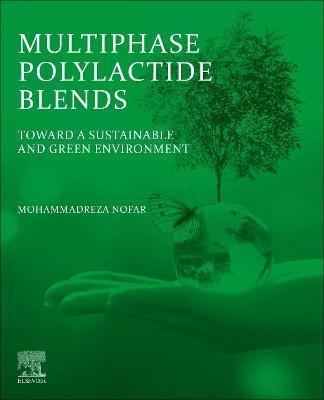
Multiphase Polylactide Blends
Elsevier Science Publishing Co Inc (Verlag)
978-0-12-824150-9 (ISBN)
More specifically, the first three chapters of this book overview the fundamentals of thermoplastic polymers, polymer blends, and structure and properties of PLA. These chapters could technically be used as a valuable textbook on the noted topics. The rest of the chapters inclusively study the fundamentals, investigations, and achievements in PLA-based blends with various types of polymers. These include miscible blends of poly L-lactide and poly D-lactide, binary immiscible/miscible blends of PLA with other thermoplastics and elastomers, PLA-based ternary blends and blend nanocomposites, as well as PLA-based blend foams.
Overall, this book provides a thorough and critical overview of the state of the art in PLA-based blends, including significant past and recent advances, with the aim of supporting and shaping further research and industrial application of these materials for the development of a green and sustainable future.
Mohammadreza Nofar, PhD is an Associate Professor in the Metallurgical and Materials Engineering Department at Istanbul Technical University, Turkey. His research focuses are polymer processing and rheology, biopolymers and PLA, polymer nanocomposites, polymer blends, microfibrillated composites, and microcellular polymer foams. He co-authored the Elsevier book 'Polylactide Foams: Fundamentals, Manufacturing, and Applications', published in September 2017.
Chapter 1. Fundamentals of thermoplastic polymers: molecular structure 1.1 Introduction to natural and synthetic polymers 1.2 Thermoplastic polymers and crystal structures 1.3 Thermal and mechanical characteristics of thermoplastics 1.4 Transition temperatures and crystallization References Chapter 2. Introduction to polymer blends 2.1 Introduction 2.2 Thermodynamics and phase miscibility 2.3 Immiscible blends: morphologies and properties 2.4 Compatibilization and interfacial properties 2.5 Mixing theories and processing 2.6 Ternary and hybrid polymer blends References Chapter 3. Polylactide (PLA): molecular structure and properties 3.1 Introduction to biopolymers and PLA 3.2 Synthesis and molecular structure 3.3 Molecular stereochemistry configurations 3.4 Glass transition temperature 3.5 Crystallization and melting behaviors 3.6 Rheological properties 3.7 Mechanical and physical properties 3.8 Degradation behavior References Chapter 4. PLLA/PDLA blends: stereocomplex crystals 4.1 Crystallization behavior 4.2 Mechanical properties 4.3 Rheological properties 4.4 Barrier and degradation properties References Chapter 5. PLA binary bioblends with other biopolymers 5.1 Blends of PLA with biobased and biodegradable polymers 5.2 Blends of PLA with biodegradable polymers 5.3 Blends of PLA with biobased polymers References Chapter 6. PLA binary blends with petroleum-based nondegradable thermoplastics 6.1 PLA-PE 6.2 PLA-PP 6.3 PLA-PS 6.4 PLA-ABS 6.5 PLA-PMMA 6.6 PLA-PET 6.7 PLA-PBT 6.8 PLA-PTT 6.9 PLA-PC 6.10 PLA-PA 6.11 PLA-PEG, PEO, or POE 6.12 PLA-POM 6.13 PLA-PVPh References Chapter 7. PLA binary blends with elastomeric polymers 7.1 PLA-rubber 7.2 PLA-PU 7.3 PLA-EVA and EVM References Chapter 8. Ternary blends of PLA 8.1 Introduction 8.2 PLA-TPS-X ternary blends 8.3 PLA-PBAT-X ternary blends 8.4 PLA-PBS-X ternary blends 8.5 PLA-PMMA-X ternary blends 8.6 PLA-Y-X ternary blends References Chapter 9. PLA blend nanocomposites 9.1 Introduction 9.2 Nanoparticles localization: thermodynamics vs kinetics mechanisms 9.3 Morphological stabilization 9.4 Morphological and rheological correlations 9.5 Induced functionalities 9.6 Mechanical properties 9.7 Structure-dependent applications 9.8 Summary Acknowledgement References Chapter 10. Foaming of PLA blends 10.1 Introduction 10.1 Miscible PLA-PLA blend foams 10.2 PLA bioblend foams 10.3 PLA blend foams with synthetic/nondegradable polymers 10.4 PLA blend foams with elastomeric polymers References Summary and Perspectives
| Erscheinungsdatum | 02.07.2021 |
|---|---|
| Zusatzinfo | 180 illustrations (30 in full color); Illustrations |
| Sprache | englisch |
| Maße | 191 x 235 mm |
| Gewicht | 840 g |
| Themenwelt | Naturwissenschaften ► Chemie ► Physikalische Chemie |
| Technik ► Maschinenbau | |
| ISBN-10 | 0-12-824150-0 / 0128241500 |
| ISBN-13 | 978-0-12-824150-9 / 9780128241509 |
| Zustand | Neuware |
| Informationen gemäß Produktsicherheitsverordnung (GPSR) | |
| Haben Sie eine Frage zum Produkt? |
aus dem Bereich


